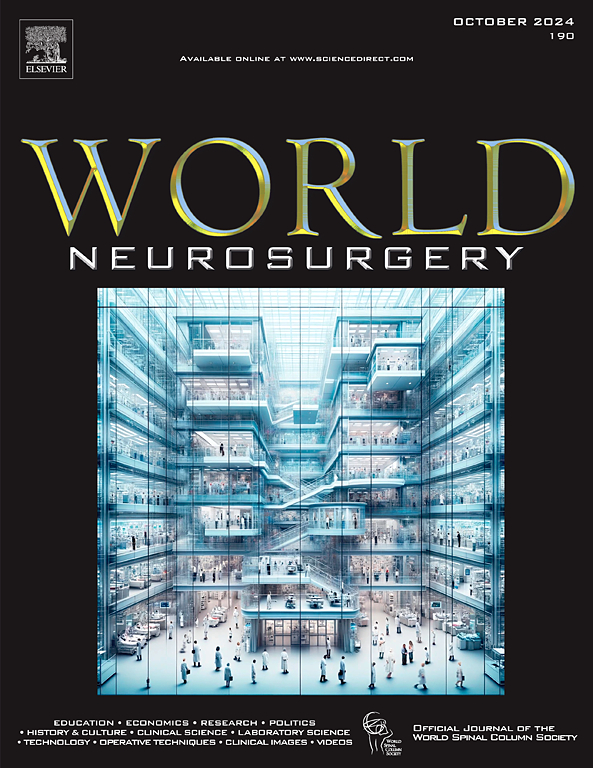Demographics and Etiologies of Patients Evaluated in a Multidisciplinary Brachial Plexus Clinic: A Ten-Year Experience
IF 1.9
4区 医学
Q3 CLINICAL NEUROLOGY
引用次数: 0
Abstract
Objective
The epidemiological distribution of patients with brachial plexus injury (BPI) has not been well described. We categorized new consultations at our specialty clinic, aiming to offer insights into demographics and presentations to guide those considering establishing brachial plexus clinics in understanding the types of patients they may encounter.
Methods
All new consultations seen at a single quaternary center's brachial plexus clinic were reviewed over a 10-year period. Patients were categorized into groups of BPI.
Results
A total of 1415 new patients were evaluated including 1009 (71.3%) males and 406 (28.7%) females with a mean age of 43.7 (standard deviation 21.1). Eight hundred and sisty-one (60.8%) cases were traumatic. One hundred and fifty-nine (11.2%) cases were iatrogenic, often due to orthopedic shoulder surgery (n = 87). Obstetric BPI comprised 150 (10.6%) cases. Parsonage-Turner syndrome was encountered in 111 (7.8%). Ninety-nine (7.0%) were believed to be a nonbrachial plexus condition. Five hundred and seventy-seven (40.8%) patients underwent surgery by our team, with common procedures being nerve transfer, tendon transfer, neurorrhaphy, arthrodesis, and free functioning muscle transfer. Types of surgery varied based on time to presentation in traumatic BPI. Underinsured status was associated with delayed presentation, and it was an independent predictor of not undergoing surgery.
Conclusions
Our experience suggests that trauma is the most common cause of BPI. Patients often present delayed, affecting type of surgical intervention rendered. A considerable number did not have a brachial plexus lesion, and the surgeon must be cognizant of alternative diagnoses. Future studies should further evaluate how demographics and socioeconomic deprivation may affect care and outcomes of BPI.
在多学科臂丛临床评估患者的人口统计学和病因学:十年的经验。
目的:臂丛神经损伤(BPI)患者的流行病学分布尚未得到很好的描述。我们对专科诊所的新会诊进行了分类,旨在提供对人口统计学和演示的见解,以指导那些考虑建立臂丛诊所的人了解他们可能遇到的患者类型。方法:所有新的咨询看到在一个单一的第四中心臂丛诊所超过十年的回顾。将患者按BPI进行分组。结果:新入组患者1415例,其中男性1009例(71.3%),女性406例(28.7%),平均年龄43.7岁(SD 21.1)。创伤性861例(60.8%)。159例(11.2%)为医源性,多为肩关节矫形手术所致(n = 87)。产科BPI 150例(10.6%)。111例(7.8%)出现Parsonage-Turner综合征。99例(7.0%)被认为是非臂丛病变。577例(40.8%)患者接受了我们团队的手术,常见的手术包括神经转移、肌腱转移、神经缝合、关节融合术和自由功能肌肉转移。创伤性BPI的手术类型根据出现的时间不同而不同。保险不足与延迟出现相关,是不接受手术的独立预测因子。结论:我们的经验表明创伤是BPI最常见的原因。患者常出现延迟、影响手术介入的类型。相当多的患者没有臂丛病变,外科医生必须认识到其他诊断。未来的研究应进一步评估人口统计学和社会经济剥夺如何影响BPI的护理和结果。
本文章由计算机程序翻译,如有差异,请以英文原文为准。
求助全文
约1分钟内获得全文
求助全文
来源期刊

World neurosurgery
CLINICAL NEUROLOGY-SURGERY
CiteScore
3.90
自引率
15.00%
发文量
1765
审稿时长
47 days
期刊介绍:
World Neurosurgery has an open access mirror journal World Neurosurgery: X, sharing the same aims and scope, editorial team, submission system and rigorous peer review.
The journal''s mission is to:
-To provide a first-class international forum and a 2-way conduit for dialogue that is relevant to neurosurgeons and providers who care for neurosurgery patients. The categories of the exchanged information include clinical and basic science, as well as global information that provide social, political, educational, economic, cultural or societal insights and knowledge that are of significance and relevance to worldwide neurosurgery patient care.
-To act as a primary intellectual catalyst for the stimulation of creativity, the creation of new knowledge, and the enhancement of quality neurosurgical care worldwide.
-To provide a forum for communication that enriches the lives of all neurosurgeons and their colleagues; and, in so doing, enriches the lives of their patients.
Topics to be addressed in World Neurosurgery include: EDUCATION, ECONOMICS, RESEARCH, POLITICS, HISTORY, CULTURE, CLINICAL SCIENCE, LABORATORY SCIENCE, TECHNOLOGY, OPERATIVE TECHNIQUES, CLINICAL IMAGES, VIDEOS
 求助内容:
求助内容: 应助结果提醒方式:
应助结果提醒方式:


